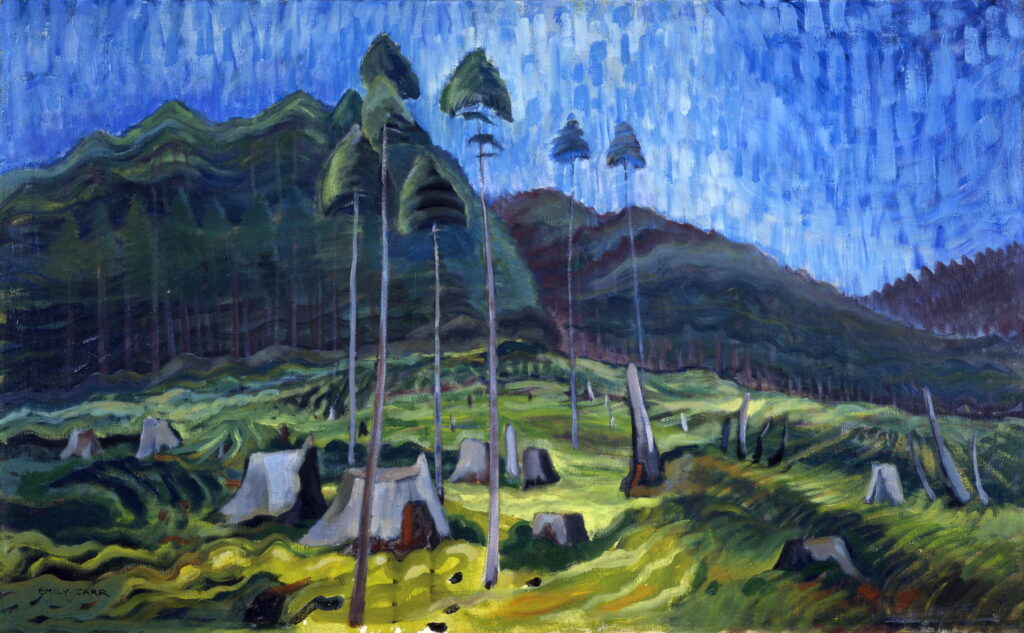Emily Carr’s paintings, Tombstones 1937-1945

At the start of 1937, Emily Carr was sixty-five, and about to confirm her international recognition with representation in group exhibitions in London’s Tate Gallery the following year, and at the New York World’s Fair of 1939. Painting from her caravan, The Elephant, she was continuing to innovate in her views of the landscape around Victoria, British Columbia.
Emily Carr (1871–1945), Above the Gravel Pit (1937), oil on canvas, 76.8 x 102.2 cm, Vancouver Art Gallery, Vancouver, BC. The Athenaeum.
Carr described Above the Gravel Pit (1937) as “a skyscape with roots and gravel pits”, that she wanted to be “free and jubilant, not crucified into one spot, static.” Her paintings in these final years of her career show the ultimate development of her brushstrokes into the unifying framework. Vibrant blue waves of the sky contrast with the greens and browns of the earth below. But Carr links the sky and trees with both hints of colour and echoing patterns made by her brush: these extend into the shallow chalk scarp and the two tree-stumps in the right foreground.
Then she suffered her first heart attack; The Elephant was too much effort for her, and she had to rent summer houses and cabins to continue her painting. She turned more to writing, and in 1941 won a literary award for her first book, Klee Wyck, a collection of short stories about her travels in the Pacific North-West.
Emily Carr (1871–1945), Dancing Sunlight (1937-40), oil on canvas, 83.5 x 60.9 cm, McMichael Canadian Art Collection, Kleinburg, ON. The Athenaeum.
In her Dancing Sunlight (1937-40), vortexes of brushstrokes have replaced all solid form. Trees, light, foliage, even the sky have been swept into those strokes sweeping across the canvas like a whirlwind. She had earlier been absorbed by abstract art, but had continued to represent real objects using techniques which restructured them, rather than abstracting.
Emily Carr (1871–1945), Somberness Sunlit (1937-40), oil on canvas, 111.9 x 68.6 cm, Provincial Archives of British Columbia, Victoria, BC. The Athenaeum.
Somberness Sunlit (1937-40) shows a similar approach, in this case with the sunlight that has penetrated through the canopy, dissolving the form of the tree trunks.
Emily Carr (1871–1945), Untitled (1938-39), oil on paper, 90.8 x 60.8 cm, Vancouver Art Gallery, Vancouver, BC. Wikimedia Commons.
Over this period, Carr had a growing concern with the deforestation occurring on the West Coast, which paralleled the earlier encroachments and destruction by Europeans of First Nations cultures. Themes that she had previously expressed in paintings such as Scorned as Timber, Beloved of the Sky (1931) were now rephrased using patterned and unifying brushstrokes, in paintings such as this untitled work from 1938-39.
Emily Carr (1871–1945), Odds and Ends (1939), oil on canvas, 67.4 x 109.5 cm, Art Gallery of Greater Victoria, Victoria, BC. Wikimedia Commons.
Odds and Ends (1939) is another of her most important paintings, not just from this period, but from her whole career. It shows the young and very high trees left behind as being of no commercial value after felling. Carr described the low stubs left on the stumps as being the trees’ tombstones.
In 1939, she suffered her second heart attack, further curtailing physical activity.
Emily Carr (1871–1945), Plumed Firs (1939-41), oil on canvas, 65.4 x 99.2 cm, University of British Columbia, Vancouver, BC. The Athenaeum.
In Plumed Firs (1939-41), Carr revisits a similar motif, following felling, with greater unification of her brushstrokes and marks between sky, forest, and the bare land left afterwards.
She suffered her first stroke in 1940, and a second in 1944. Although she continued to paint in her final years her pace was drastically reduced, and she concentrated her efforts on writing.
Emily Carr (1871–1945), A Skidegate Beaver Pole (1941-42), oil on canvas, 86.2 x 76 cm, Vancouver Art Gallery, Vancouver, BC. The Athenaeum.
In 1941-42, Carr painted a small series based on her earlier sketches and paintings among the First Nations peoples in around 1912. A Skidegate Beaver Pole (1941-42) is one of those, developed from a group of sketches made in the Haida village of Skidegate in 1912. Its totem is painted more confidently earlier; those old sketches and paintings now looked tentative in their careful accuracy. Here the surrounding vegetation, forest and sky are all expressed in swirling brushstrokes.
In August 1942, she travelled to Mount Douglas Park, near Victoria, for her last painting trip. She had been organising works to be given in trust for the citizens of British Columbia, which now form the core of the Emily Carr Trust collection. She died in 1945.
References
Wikipedia.
Lisa Baldissera (2015) Emily Carr, Life & Work, Art Canada Institute. ISBN 978 1 4871 0044 5. Available in PDF from Art Canada Institute.
Thom, Ian M (2013) Emily Carr Collected, Douglas & McIntyre. ISBN 978 1 77100 080 2.



